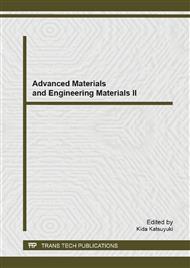[1]
P.M.S. Monk, R.J. Mortimer, R.J. Rosseinsk: Electrochromism and Electrochromic Devices (Cambridge: Cambridge University Press 2007).
Google Scholar
[2]
C.G. Granqvist: Handbook of In organic Electrochromic Materials (Elsevier, Amstrerdam 1995).
Google Scholar
[3]
J. Scarminio, A. Urbano, B. Gardes: Mater. Chem. Phys. Vol. 61 (1999), p.143.
Google Scholar
[4]
M. Deepa, A.K. Srivastava, S. Singh, S.A. Agnihotry: J. Mater. Res. Vol. 19 (2004), p.2576.
Google Scholar
[5]
S.H. Lee, R. Deshpande, P.A. Parilla, K.M. Jones, B. To, H. Mahan: Adv. Mater. Vol. 18 (2006) , p.763.
Google Scholar
[6]
S.Y. Park, J.M. Lee, C. Noh, S.U. Son: J. Mater. Chem. Vol. 19 (2009), p.7959.
Google Scholar
[7]
R.S. Crandall and B.W. Faughnan: Appl. Phys. Lett. Vol. 26 (1975), p.120.
Google Scholar
[8]
G. Gu, B. Zheng, W.Q. Han, S. Roth, J. Liu: Nano Lett. Vol. 2 (2002), p.849.
Google Scholar
[9]
Y.B. Li, Y. Bando, D. Golberg: Adv. Mater. Vol. 15 (2003), p.1294.
Google Scholar
[10]
B.B. Lakshmi, P.K. Dorhout, C.R. Martin: Chem. Mater. Vol. 9(1997), p.857.
Google Scholar
[11]
K. Lee, W.S. Seo, J.T. Park: J. Am. Chem. Soc. Vol. 125 (2003), p.3408.
Google Scholar
[12]
X.W. Lou, H.C. Zeng: Inorg. Chem. Vol. 42 (2003), p.6169.
Google Scholar
[13]
Z.J. Gu, T.Y. Zhai, B.F. Gao, X.H. Sheng, Y.B. Wang, H.B. Fu, Y. Ma, J.N. Yao: J. Phys. Chem. B. Vol. 110 (2006), p.23829.
Google Scholar
[14]
B. Liu, H.C. Zeng: J. Am. Chem. Soc. Vol. 126 (2004), p.16744.
Google Scholar
[15]
F. Amano, K. Nogami, R. Abe, B. Ohtani: J. Phys. Chem. C. Vol. 112 (2008), p.9320.
Google Scholar
[16]
Y. Ding, S.H. Yu, C. Liu, Z.A. Zang: Chem. Eur. J. Vol. 13 (2007), p.746.
Google Scholar
[17]
B. Liu, S.H. Yu, L.J. Li, Q. Zhang, F. Zhang, K. Jiang: Angew Chem. Int. Ed. Vol. 43 (2004), p.4745.
Google Scholar
[18]
Y. Zhao, Y. Xie, X. Zhu, S. Yan, S.X. Wang: Chem. Eur. J. Vol. 14 (2008), p.1.
Google Scholar
[19]
W.L. Xiong, W. Yong, Y. Chongli, Y.L. Jim, A.A. Lyden: Adv. Mater. Vol. 18 (2006), p.2325.
Google Scholar
[20]
B. Liu, H.C. Zeng: Small Vol. 1 (2005), p.566.
Google Scholar
[21]
B.X. Li, G.X. Rong, Y. Xie, L.F. Huang, C.Q. Feng: Inorg. Chem. Vol. 45 (2006), p.6404.
Google Scholar
[22]
J.M. Wang, E. Khoo, P.S. Lee, J. Ma: J. Phys. Chem. Vol. 113 (2009), p.9655.
Google Scholar
[23]
K. Senthil, K. Yong: Nanotechnology Vol. 18 (2007), p.395604.
Google Scholar
[24]
C. Zhang, A. Boudiba, C. Navio, C. Bittencourt, M.G. Olivier, R. Snyders, M. Debliquy: Int. J. Hydrogen Energy Vol. 34 (2011), p.1107.
DOI: 10.1016/j.ijhydene.2010.10.011
Google Scholar


